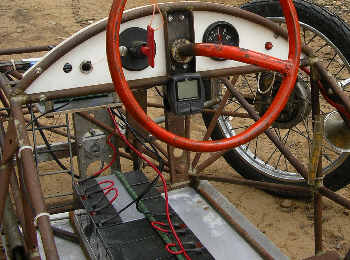NB: The Battery system is being updated (late 2020).
Previously the vehicle was powered by a 36 Volt battery pack
consisting of 6 small 12 Volt batteries connected in series-parallel.
The pack (pictured) is mounted on the floor between the driver's legs.
The only instrumentation used is an ammeter, although a cheap multimeter is often attached to monitor the battery voltage under load.
Charging is effected off-vehicle using a 12 Volt automotive charger to charge one battery at a time.
The charger has been modified to cut out at 14.4 Volts so as not to cook the batteries.
